If technology is the brain of a modern yacht, then Damien Kent and Toby Teele are responsible for the central nervous system. In this month’s Dispatch, Lyman-Morse’s expert systems duo discuss how Process Logic Controllers have transformed the way power is managed onboard and, when necessary, loads are shed. We also hear from a family whose connection to their Lyman-Morse boat was so strong, the second generation refused to sell their yacht when their parents passed away. Finally, we check in with the crew at Lyman-Morse Fabrication about some of the awesome metal projects they are working on these days. Our monthly Dispatches give you an in-depth look at an assortment of projects we’re working on in both Thomaston and Camden.
In this issue:
Managing Shipboard Power: Lessons in Load Shedding
Ties That Bind: Keeping Sea Chase IV in the Family
Dazzling Metal Fabrication Projects
Managing Shipboard Power: Lessons in Load Shedding
 Toby Teele and Damien Kent design and build the brains and nervous systems for boats. They are Lyman-Morse’s masters of the suddenly ubiquitous emerging technology in marine engineering called process logic controllers, or PLCs.
Toby Teele and Damien Kent design and build the brains and nervous systems for boats. They are Lyman-Morse’s masters of the suddenly ubiquitous emerging technology in marine engineering called process logic controllers, or PLCs.
“A PLC is just a fancy word for being able to control anything, remotely,” says Toby.
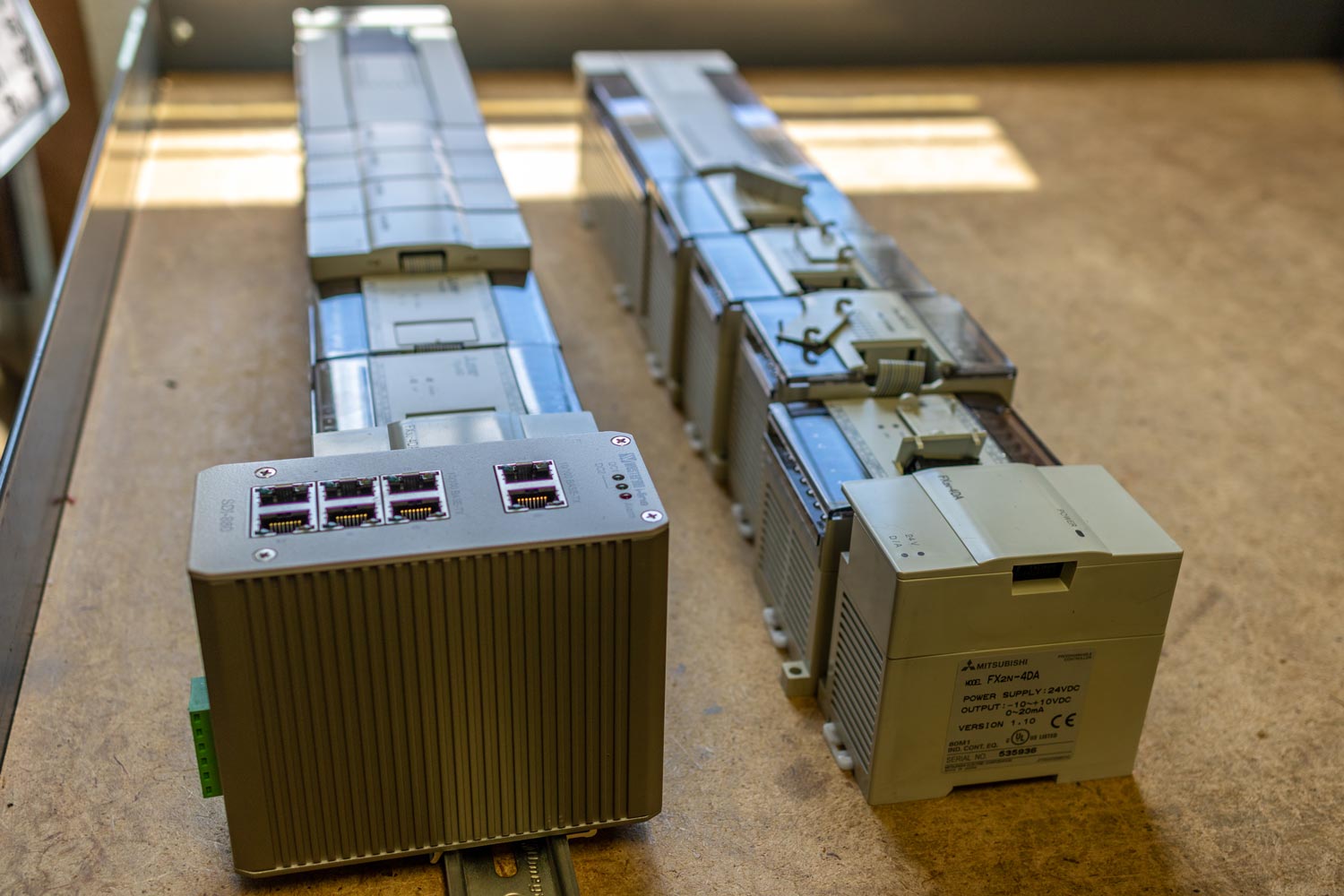 He and Damien work out of an office, cum supply room filled with control modules, circuit diagrams and parts catalogues on the second floor of Building 11, at Lyman-Morse’s main campus in Thomaston. The two spend part of their day fielding questions from captains, mechanics, managers, and owners about how PLC systems can make a boat smarter. The rest of the time, they design and supervise the installation of systems in both sail and power boats.
He and Damien work out of an office, cum supply room filled with control modules, circuit diagrams and parts catalogues on the second floor of Building 11, at Lyman-Morse’s main campus in Thomaston. The two spend part of their day fielding questions from captains, mechanics, managers, and owners about how PLC systems can make a boat smarter. The rest of the time, they design and supervise the installation of systems in both sail and power boats.
“If you wanted to open that door with a press of a button, we can tell you all the rams, hydraulics, and optical sensors needed,” says Toby. “If you have any kind of mechanical system, we can automate it.”
Toby spent six years managing the production logic for a food automation company in central Florida. Damien has a degree in IT administration and learned his way around process logic control from hands-on work at Lyman-Morse. Both played a central role, back in 2010, in bringing the technology to the firm’s first major PLC project: a 48-foot S&S daysailer called Aileen. And these days, both are deep in designing the process logic control tools in a massive refit of a Swan 100.
“We just kept bringing the idea of PLCs up because we knew they were the future,” says Toby. “Now they play a major role in many of the jobs here.”
 What gets both Toby and Damien excited is explaining the bright prospects for PLCs, as costs drop and newer options from the technology flow into marine engineering. One of the more compelling new tools for lower-cost process logic marine control is CZone, a fast-growing New Zealand-based marine control company. While its line of monitoring and automation tools are nowhere near as powerful as the bespoke PLC systems Toby and Damien install, a CZone system can automate the basic systems for many boats, like hydraulics, power management, and ventilation.
What gets both Toby and Damien excited is explaining the bright prospects for PLCs, as costs drop and newer options from the technology flow into marine engineering. One of the more compelling new tools for lower-cost process logic marine control is CZone, a fast-growing New Zealand-based marine control company. While its line of monitoring and automation tools are nowhere near as powerful as the bespoke PLC systems Toby and Damien install, a CZone system can automate the basic systems for many boats, like hydraulics, power management, and ventilation.
“We just retrofitted one for a boat,” says Damien. “It’s not as flexible as a custom PLC system; but it brings most of the important features and it’s much cheaper.”
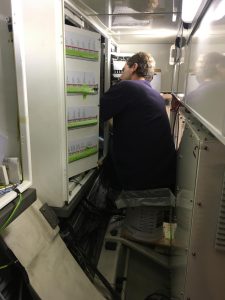 But they also have bigger ideas for low-cost PLCs. The most appealing is installing simple, so-called current transformers on the electrical lines that power the main systems in a boat, like air conditioning, hot water, electrical appliances, and deep-charging battery systems.
But they also have bigger ideas for low-cost PLCs. The most appealing is installing simple, so-called current transformers on the electrical lines that power the main systems in a boat, like air conditioning, hot water, electrical appliances, and deep-charging battery systems.
Such current transformers, or CT’s as they are often called, can cost as little as a few hundred dollars and can be installed with simple screws and wiring. Smartly installed current transformers could offer powerful benefits similar to process logic controllers. CTs could sense and report the actual current flowing around a boat; and just like more complex PLC systems, pass that critical data to a low-cost display, alarm system or automatic cut-off switch.
“The average boat we see in the 55- to 60-foot range has become a city of technologies,” says Toby. “They don’t just have one fridge, they have three. All that complexity requires ever bigger generators and circuits.”
In theory, a well-designed CT monitoring system that they propose would offer a low-cost means of easily rationing a boat’s power. The secret is by simply tracking and then turning off unwanted capabilities. So, similar to how a well-managed smartphone turns off unwanted apps to extend battery life, if a boat is under sail with no need for climate control, the CT relay could signal the crew that it’s time to turn off — or shed the load — of the air conditioning or heating.
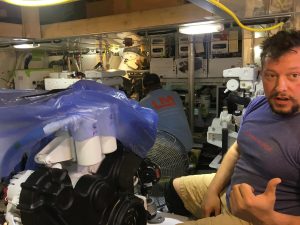 Real-world applications could be more complex, since every individual boat has its own uses and power needs both say, but a simple, well managed load-shedding system made with current transformers could be very affordably installed. “If you do it right, a CT system would allow you to install a much smaller generator that lasts twice as long and is far lighter and needs less fuel,” says Toby.
Real-world applications could be more complex, since every individual boat has its own uses and power needs both say, but a simple, well managed load-shedding system made with current transformers could be very affordably installed. “If you do it right, a CT system would allow you to install a much smaller generator that lasts twice as long and is far lighter and needs less fuel,” says Toby.
“We could do that for pretty much every boat we touch here,” says Toby. “And who wouldn’t love that?”
Ties that Bind: Keeping Sea Chase IV in the Family
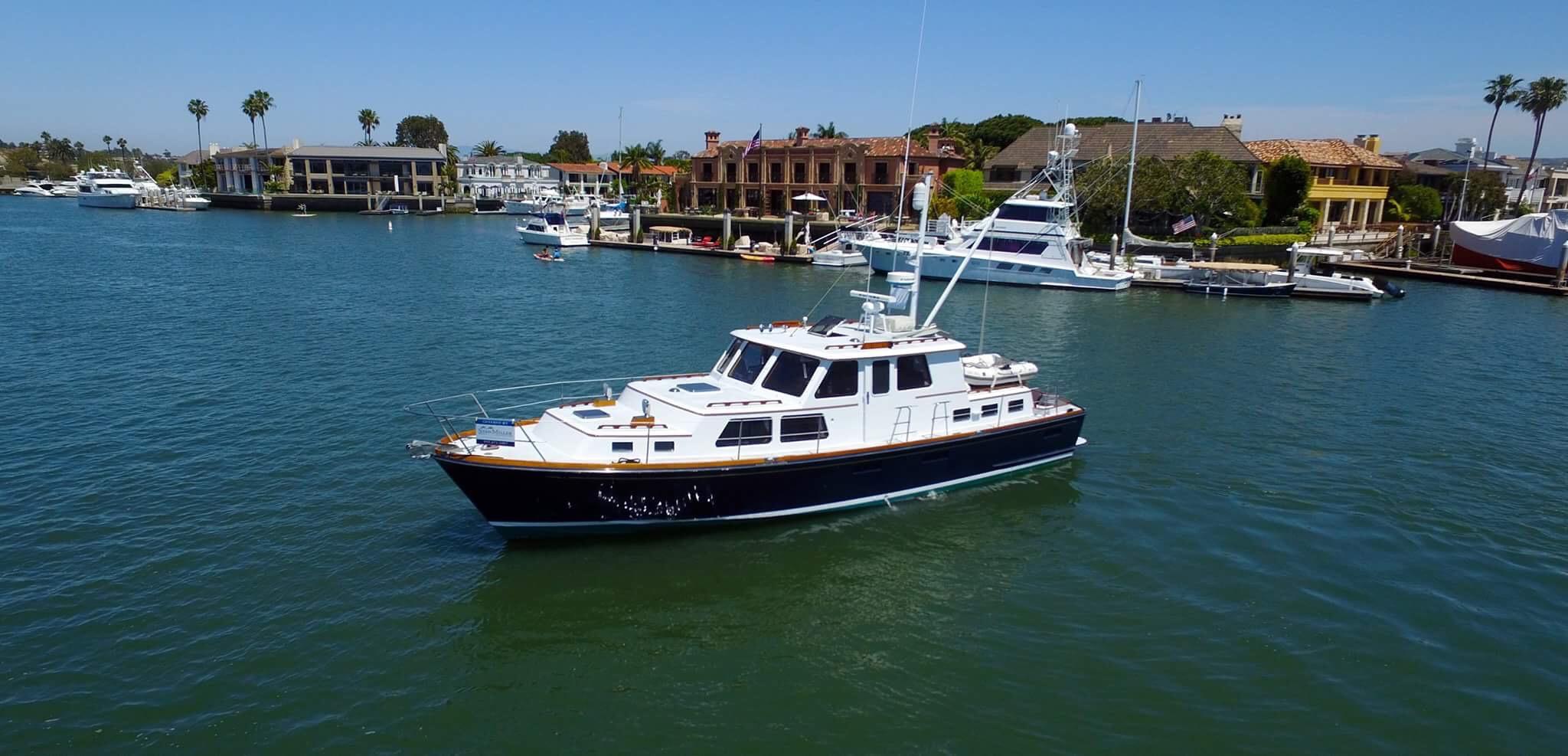 It’s always a bittersweet moment when an old flame shows up. And so it was, a couple of months back, when the glamorous Sea Chase IV came in for a major refit.
It’s always a bittersweet moment when an old flame shows up. And so it was, a couple of months back, when the glamorous Sea Chase IV came in for a major refit.
This C. Raymond Hunt-designed classic cruiser was one of our first crushes. We built her mostly from pure love, back in 1991 just after we took over the Wallace boatyard, here at the Thomaston waterfront. Ray Hunt boats like Sea Chase IV were in their day a revolutionary Deep Vee design; wholesome, sea-kindly handling with oodles of space and comforts all over. Our appreciation of those characteristics is still high. We adored building Sea Chase IV. And her owner and his family adored owning her. The vessel saw deep family duty mostly cruising the Southern California coast for about 25 years.
 After the owner passed, Sea Chase IV was placed in a trust, then deemed too much of a “project” and was put up for sale. She spent two years on the market, but no proper buyer emerged.
After the owner passed, Sea Chase IV was placed in a trust, then deemed too much of a “project” and was put up for sale. She spent two years on the market, but no proper buyer emerged.
But fear not, good will prevailed! The owner’s daughter, Lisa, and her husband, Jim, decided that Sea Chase IV deserved a fresh run at making new family memories. So last summer they committed to restoring this boat as a platform for the next chapter in their own lives as summer live-aboards in Maine.
We chatted with Jim and Lisa over a few phone calls. Here are their comments edited for length and clarity.
How did you actively begin looking at Maine and bringing Sea Chase IV back to Lyman-Morse?
We rented a place in Camden Harbor. We drove around the coast, south to Boothbay Harbor and north to Bar Harbor. We spent most of the time thinking that, “Wow, this place would look really cool from the water.” We began to think about getting the boat shipped east. We could always put her back on the market in Maine, where she should sell more easily.
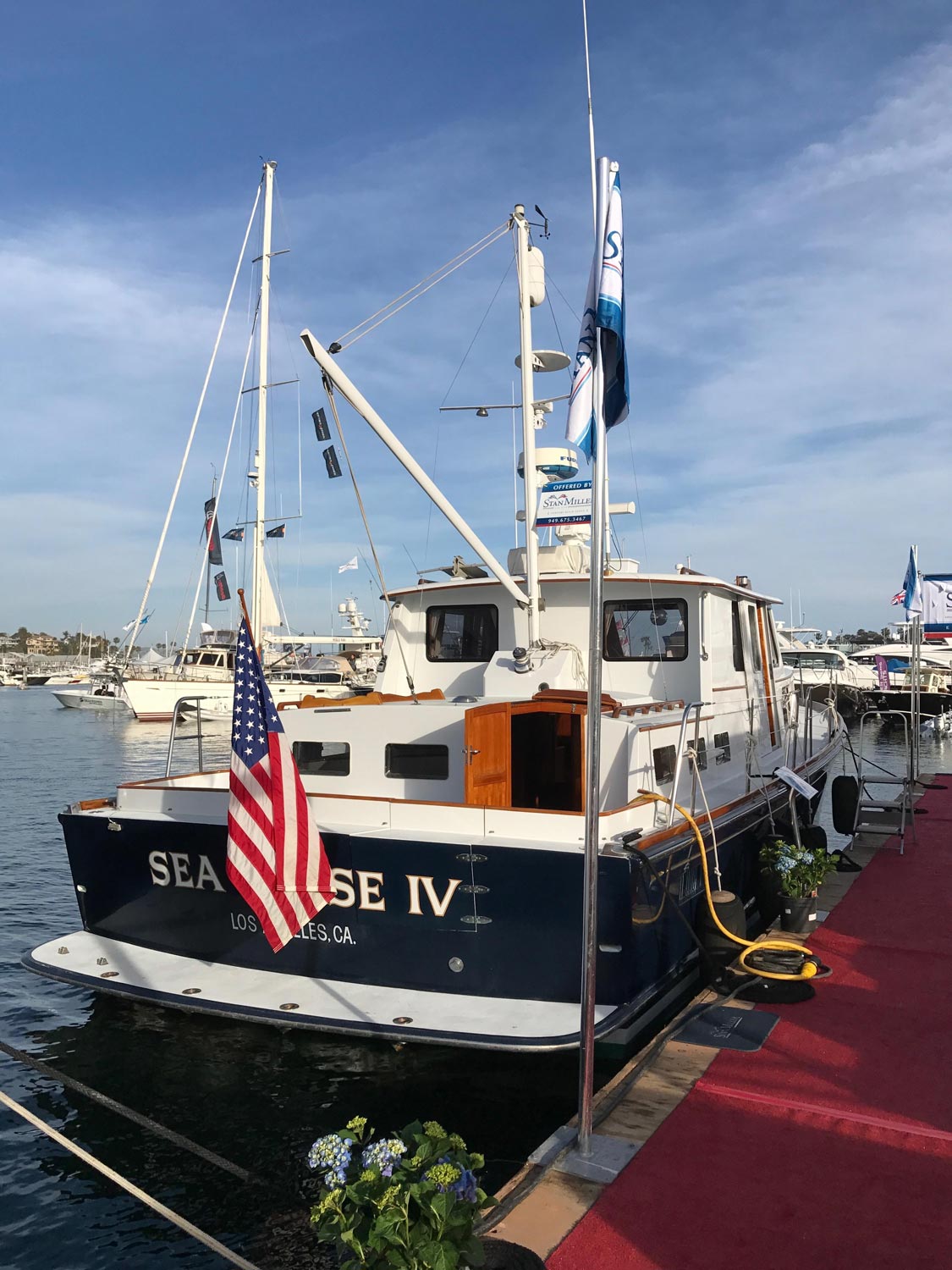 Then one evening, we were sitting on the balcony overlooking the harbor and we just kind of said, “You know what, we should send a note to Drew Lyman about bringing this boat back to life.”
Then one evening, we were sitting on the balcony overlooking the harbor and we just kind of said, “You know what, we should send a note to Drew Lyman about bringing this boat back to life.”
A boat refit is a big project. What steps did you take to investigate the process?
When my husband talked about this, I was kind of shocked. Usually he’s so practical. But our oldest son came for a visit and he was adamant that we could not sell grandpa’s boat. The memories mattered. I don’t want this to sound like a commercial or anything, but we felt like this was going to be OK.
My mom and dad loved working with Cabot. I knew we would be in good hands.
We found the bottle we used to christen Sea Chase IV. And the note from Cabot and Heidi thanking my mom and dad for the work and how much they loved building the boat. All that comes through when you are on-board.
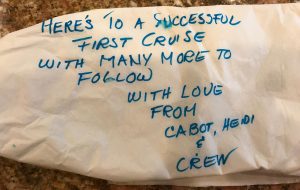 It is not just any job for them. It is a passion for them, at least at some level. And everybody we met at Lyman-Morse loves it there.
It is not just any job for them. It is a passion for them, at least at some level. And everybody we met at Lyman-Morse loves it there.
What did you decide to do during this stage of the refit?
It was obvious that the bottom had to be redone. The electrical was all original, and that had to all come out. I personally was inclined to replace the generators and maybe the engines. But LM said: ‘Let’s get her back to life. And then, after a summer or two of using her, we will see what you actually need.’
The boat was set up for long-range cruising with a big generator, small batteries, and a big watermaker. In the first summer or two, our horizon will be the Maine coast. Then we might decide if we want longer-range trips. But for now, we concentrated on the creature comforts like AC, heating, and the finishes like varnish and paint and new cushions both inside and out. We think it’s a smart approach.
You chose to skipper your own boat. Explain the choice of being responsible for your own destiny on the water.
We took the choice seriously. We are reasonably comfortable on boats. My dad made my mom and me take Power Squadron training when I was 14. We have great respect for what it takes to run a boat. We did a lot of reading and we spent a week at the Southwest Florida Yacht Training school.
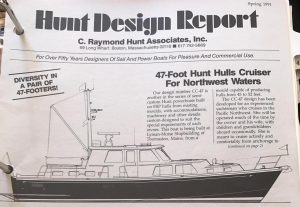 We got the basics of boat handling, systems, anchoring, radio use. All of that kind of stuff. I can change my own oil, though I will never do it. Lyman-Morse will send someone to help us. If we are not comfortable, we can hire a training captain. I just don’t have as much angst about it as when I first started.
We got the basics of boat handling, systems, anchoring, radio use. All of that kind of stuff. I can change my own oil, though I will never do it. Lyman-Morse will send someone to help us. If we are not comfortable, we can hire a training captain. I just don’t have as much angst about it as when I first started.
We can definitely figure this out.
What are the lessons you have learned so far?
We learned to have patience and humility. That is why we did all the training. Don’t be in a hurry. Realize everybody is doing the best they can. Trade duties, so people realize what is required. Don’t rush out. If you need to turn around and come back to the dock for the second, third, or fourth time, do it.
We’ve all seen the stressed-out patriarchal “dude” screaming at his wife trying to dock the boat in front of everybody at the harbor. We don’t want to be those people.
One of the best lessons we had was from our training skipper, who said: “Remember folks, this is supposed to PLEASURE BOATING.”
Heavy Metal: The Fab Shop Report
 At one point or another, we all dream of having a Fab Shop. Who doesn’t pine for a brightly lit, lofty space that comes magically pre-loaded with the talent, parts, and tools needed to make anything out of just about anything?
At one point or another, we all dream of having a Fab Shop. Who doesn’t pine for a brightly lit, lofty space that comes magically pre-loaded with the talent, parts, and tools needed to make anything out of just about anything?
 Our 15,000 square-foot Lyman-Morse Fabrication division, located in Thomaston near the border with Rockland, is just such a production paradise. We stopped in for a chat and tour with shop manager Jonathan Egan and assistant manager Bill Froehlich.
Our 15,000 square-foot Lyman-Morse Fabrication division, located in Thomaston near the border with Rockland, is just such a production paradise. We stopped in for a chat and tour with shop manager Jonathan Egan and assistant manager Bill Froehlich.
We can confirm that Jonathan and Bill, and a team of about two-dozen skilled craftspeople, really can fabricate just about everything from aluminum, to stainless and carbon steel and every other exotic alloy imaginable. They can bend pipe and make the finest structural welds. They cut sheet metal, and pound iron like a blacksmith. They craft machine fittings and sculpt digital files. They finesse computer-controlled cutters and are pretty darn handy with paper and pencil.
The clients that LM Fabrication serves across aquaculture, high-end architecture, commercial construction and defense are as varied as the fab shop’s own skills.
Here are three projects currently in the pipeline.
Bridge Architectural Access Plates
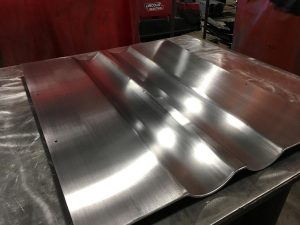 When it came time to upgrade a bridge that spans a river between Manhattan and the mainland (Note: we’re not allowed to name the bridge), somebody had to make the five, roughly 4-foot by 30-inch, stainless-steel fittings that shield various sensitive features in the span. The work fell to Jonathan and his team, who started out with flat quarter-inch stainless steel plate. The team then engineered a special jig to capture the tricky half-round radiuses that define the mid-section of that plate and then flatten the rest of the sheet back to its original shape to match that section in the bridge. From there, the piece was further shaped by a giant hydraulic press brake, made by Turkish maker Toskar.
When it came time to upgrade a bridge that spans a river between Manhattan and the mainland (Note: we’re not allowed to name the bridge), somebody had to make the five, roughly 4-foot by 30-inch, stainless-steel fittings that shield various sensitive features in the span. The work fell to Jonathan and his team, who started out with flat quarter-inch stainless steel plate. The team then engineered a special jig to capture the tricky half-round radiuses that define the mid-section of that plate and then flatten the rest of the sheet back to its original shape to match that section in the bridge. From there, the piece was further shaped by a giant hydraulic press brake, made by Turkish maker Toskar.
“We nickname the Toskar ‘Oscar,’ because he can be a grouchy machine,” says Egan. “It is incredibly challenging to get those plates flat again, once we’ve started welding them .”
Creating a Steel Dancer Just Right
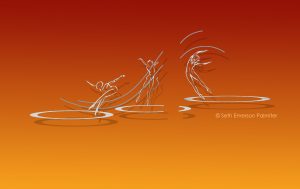 Seth Emerson Palmiter is a Rockport-based sculptor who needed sheet stainless steel cut into exacting shapes for a 30- by 15-foot integrated hanging ballerina sculpture he was creating for the Lauderhill Performing Arts Center, in south Florida. To get the tolerances just right for his steel, crystal glass, and LED installation, he turned to his long-time collaborator, Bill Froehlich at LM Fabrication.
Seth Emerson Palmiter is a Rockport-based sculptor who needed sheet stainless steel cut into exacting shapes for a 30- by 15-foot integrated hanging ballerina sculpture he was creating for the Lauderhill Performing Arts Center, in south Florida. To get the tolerances just right for his steel, crystal glass, and LED installation, he turned to his long-time collaborator, Bill Froehlich at LM Fabrication.
“What a lot of people don’t realize about computer-controlled cutting tools is there is a wide range of quality depending on how you manage your cutters,” says Seth. Slower cuts tend to generate cleaner work, but cost more. While faster cuts save time and money; but they can result in messier incisions. Seth says he relies on Bill and LMF to understand what cut quality is needed where, and then orchestrate the cutting machinery accordingly.
“There’s a strong alliance between sculptors and boat builders,” he says. “Both realize forms have to be strong, lightweight, and durable. I can count on Bill to intuitively understand the scope of what I am trying to achieve.”
Stairway to Stainless Heaven
 Stairways in otherwise-cramped Manhattan apartments have to be both fabulous looking and fabulously well engineered. So, when plans for a roughly 16-foot tall spiral stair destined for a New York City duplex came to the shop, careful work needed to be done so the unit would fit. Literally. Obviously, the 1890-pound, mostly stainless-steel stairway was not going to fit in the service elevator so it is engineered by LM designer Kevin Houghton to break down into three separate pieces so it can fit through a window on the 24th floor!
Stairways in otherwise-cramped Manhattan apartments have to be both fabulous looking and fabulously well engineered. So, when plans for a roughly 16-foot tall spiral stair destined for a New York City duplex came to the shop, careful work needed to be done so the unit would fit. Literally. Obviously, the 1890-pound, mostly stainless-steel stairway was not going to fit in the service elevator so it is engineered by LM designer Kevin Houghton to break down into three separate pieces so it can fit through a window on the 24th floor!
“A spiral stairway is challenging enough when it is one piece welding,“ says Jonathan. “But when the unit has to be made in separate elements and bolted up on site, and still have a seamless appearance, that is a different story.”
Want to make sure you don’t miss next month’s Dispatches? Click Here to have them sent directly to your inbox.
